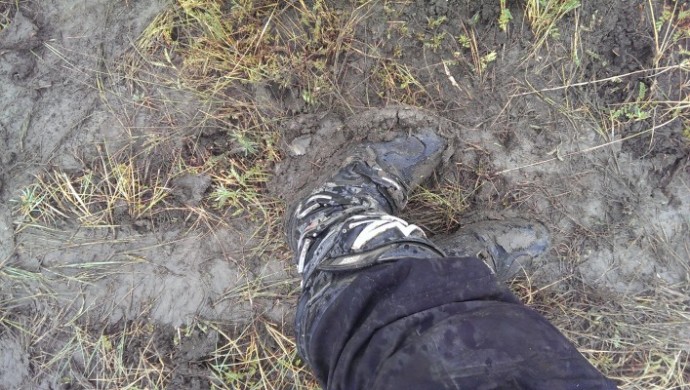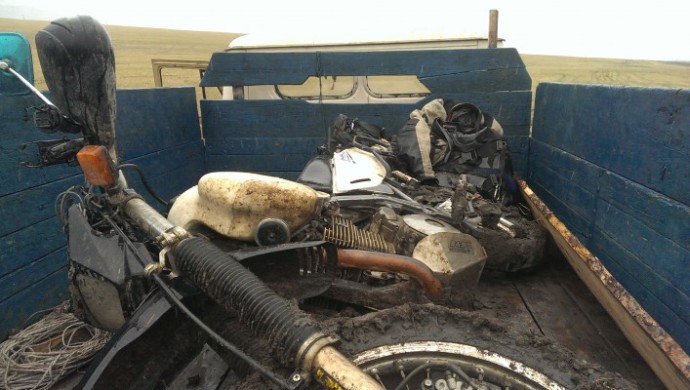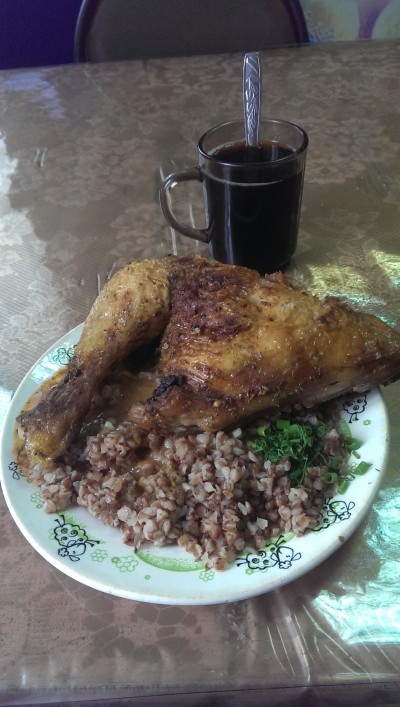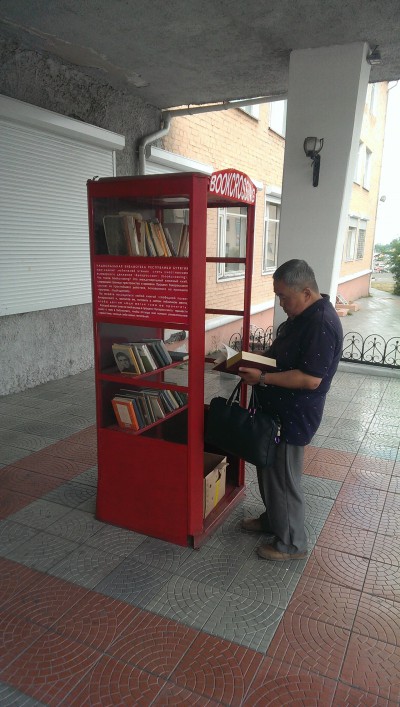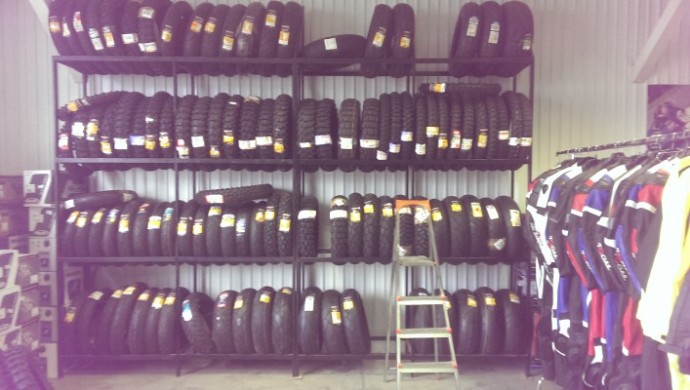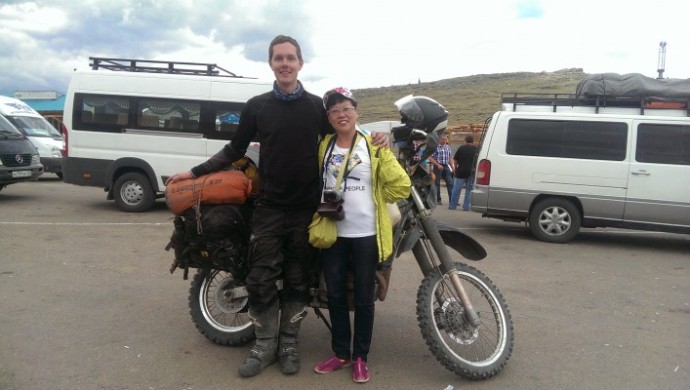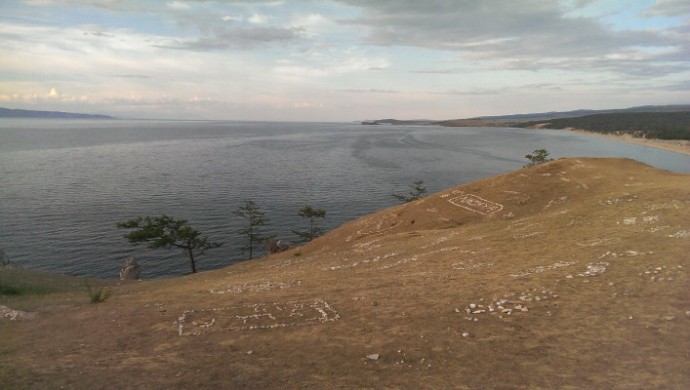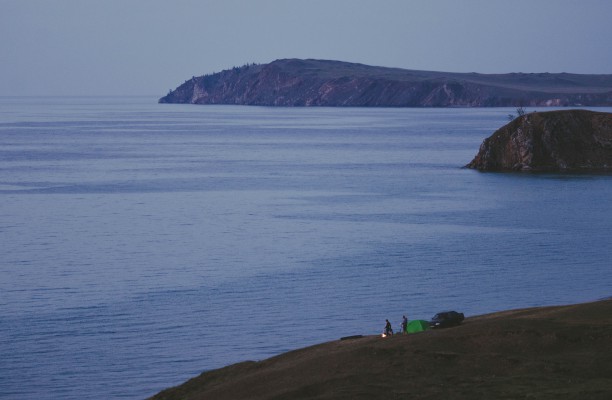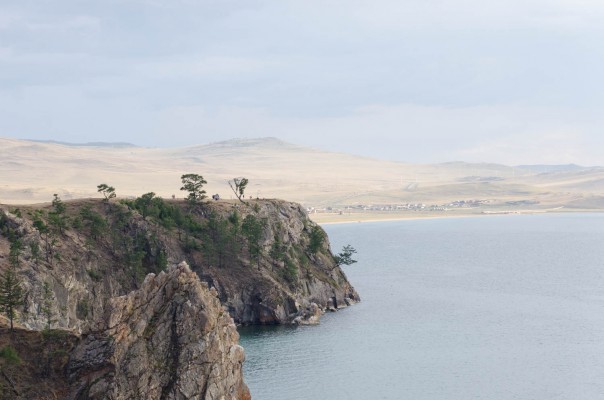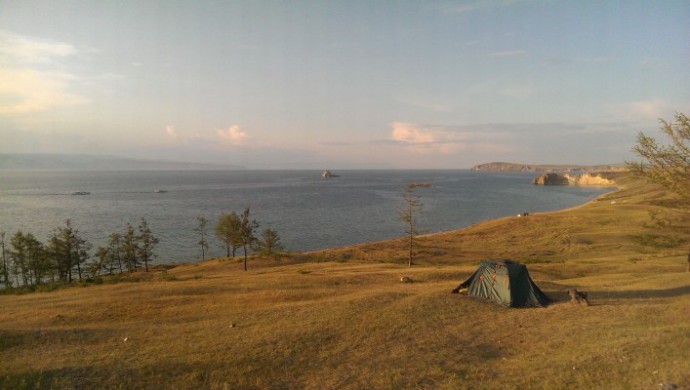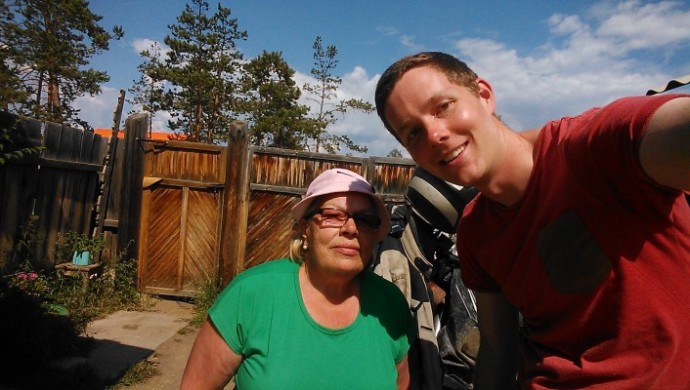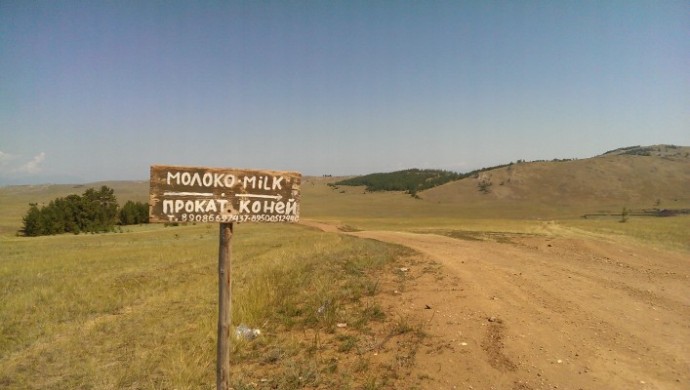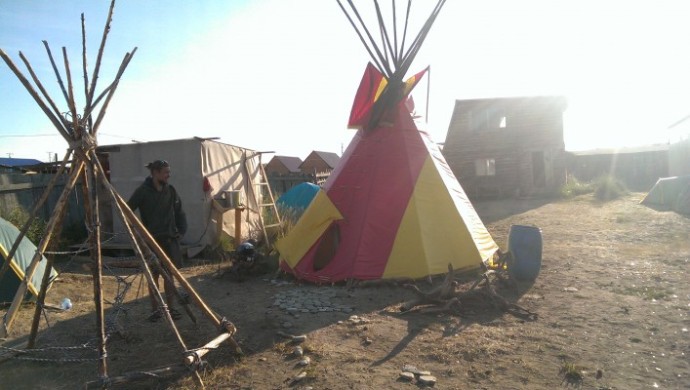I awoke to the sound of rain gently falling on my tent. A soothing sound, like the noise of the breakers I had heard all night, camped as I was right on the pictureshore shoreline of Lake Baikal.
Wait, rain? Oh no. Getting away from the picturesque shoreline of Lake Baikal involved a steep hill climb back up to the main track. The previous day in hot, dry weather it hadn’t even crossed my mind that I might have trouble getting out. Now, every falling raindrop was making the path more muddy. I had to get the campsite packed up: it was a race against time.
No breakfast, and I had everything on the bike in record time and was only slightly wet and slightly miserable. But it was good to be going. I rolled forward two metres, and the bike promptly fell over in the mud. Oh god.
Because of the steep slope, I couldn’t pick the bike up without taking large amounts of luggage off. It took me an hour to move the 200m up that hill on the steeply cambered, muddy track: after the bike slid sideways and fell over the third time I took everything off, walked the bike up, then did three trips in my boots, in the mud, in the rain to get my stuff. Without breakfast, or more to the point, coffee. After three idyllic days camping, this was a shock.
Packed again and ready to go at the top of the hill, the next challenge was the 15km back to Khuzir – the main town on Olkhon Island. I knew the road was a bit muddy, and worse – there were two huge gulleys to traverse: you get a 30 degree slope down, followed by some sand at the bottom and then the same back up. The depth is perhaps 20 metres. I’d done them a number of times in the dry; a lot of fun on a dirtbike. In the mud, though, with a loaded bike and my limited off-road experience? I was apprehensive. But it was all of 15km to town, so I figured I would take it carefully. I had my eyes set on breakfast, the ferry, and the lovely tarmac all the way back to a hot shower in Irkutsk.
The first one, the smaller one, went ok. I didn’t trust the front brakes to have any effect whatsoever in the mud, but as it turned out engine-braking the rear didn’t do much either except slide me sideways, so halfway down it ended up being a pull-the-clutch-and-hope-for-the-best kind of affair. But I made it up the other side, pleased with myself, and hey it was pretty fun once the panic wore off.
The next gully was the big one… this time I got off and walked to the edge. It was deeper than I remembered, incredibly steep, and the track was pure extra-slippery mud. There was no way I was going to keep the bike upright without brakes.
But lo! Off to the left was a track along the side of the hill, clearly used in exactly this scenario. Still steep, but covered in large rocks and washouts which were perfect for my requirement: provide a bit of grip so I could use the brakes. I negotiated my way down, sliding from rock to rock, and zoomed back up the other side. Obstacle negotiated! I gave myself a pat on the back.
The third challenge was about 9km out of town, where the road looked like it got a bit muddy in the wet. In the dry it was ok if you took it slow, and I figured it hadn’t been raining that long, so it couldn’t be that bad.
Oh boy. I’d never seen mud that bad; not in Australia, not on the Kolyma Highway, nowhere. It was deep and thick and sticky, and built up a solid layer on things it came into contact with, so my tyres turned into smooth wheels of mud, and my boots had around 10cm of extra height from the platform of mud that stuck to them. It was baaaad. Bad bad bad. Did I mention that I hate mud?
I walked the bike along slowly, stopping every 50m or so to take a break from pushing and knock the couple of kilos of mud off my boots. I only had about 400m of mud, and then I knew the road improved back to “waterlogged sand track”. The bike was running hot from the lack of airflow, with a powerful smell of baking mud as the exhaust manifold gently cooked everything it came into contact with. I told it to hang in there, not much longer to go.
And then my rear wheel got stuck; I revved the engine but the bike wasn’t going anywhere. I looked back to see just how deep a hole I’d dug myself into and saw that the wheel wasn’t even turning when I let the clutch out. Uh oh.
My clutch had gone.
I spent a few seconds just sitting on the bike in disbelief. Perhaps in a moment I would wake up in my tent and this would all be a bad dream. But no, I opened my eyes and I was still sitting on the very real, very broken bike, and the very wet rain was still falling gently on the very, very sticky mud.
I slowly repacked my valuables into a few small bags. I would need to hitch a lift into town and organise some sort of truck to pick up the bike. I had no idea how to do either; unlike certain professional-hitchhiker friends of mine I have never hitched a ride in my life. However, the bike was conveniently stopped right in the middle of the track, and there was no way it was going anywhere without a team of people to push it out of the mud, so all the cars – people returning from weekend camping holidays – were having to slow down and slide dangerously around me. I sort of flailed at the first one to pass.
The driver looked at me, a foreigner smiling nervously and covered in black mud from helmet to boots. “I’m sorry, the car is full,” he said, pointing at the three small items on his front seat. I didn’t bother arguing, I wouldn’t pick me up either.
I skipped the next few cars and flailed more firmly at a Lada minivan. The two guys in the front didn’t quite seem to follow, but I was more insistent about wanting to go to Khuzir, and how it was only 9km away and all that, and so they eventually said yes. Score. I jumped in the back on one of the bench seats, slammed the ancient sliding door, we took off, and 200m down the road I realised I’d left the keys on the bike. But they weren’t stopping, so I figured that if someone was going to nick the bike in the mud with a broken clutch they probably deserved it.
Dropped off at the supermarket in Khuzir, I grabbed breakfast and then walked back to the guesthouse run by the lovely Alia. She was surprised to see me, but upon understanding that my bike was stuck told – or rather, instructed – me to go and rest, and began dealing with the matter with a certain ruthless Russian efficiency. Inside of 30 minutes a man named Slava had rocked up in an ancient Soviet truck, Alia-the-charming-grandmother calmly handed me her enormous chainsaw – I’m not entirely sure why, perhaps in case we needed to fell some trees and build a log cabin – and we bounced off back down the road.
By the time we arrived back at the bike the mud had claimed another victim; a Kia trying to take a shortcut to the south of the road was stuck in a big way, with the family in the back seat. Noone was particularly upset; my experiences getting bogged in Australia have generally involved a lot of swearing, but in Russia it’s more “oh-well-let’s-hang-out-and-wait-for-a-truck”. The Kia driver came and enthusiastically helped with the bike, on the understanding that he would get a free tow from Slava in return. We contemplated the problem in the light rain: three people, 150kg bike on the ground, truck tray a decent 1.5m above.
I knew from painful experience in Japan that getting my bike on and off even small trucks was a mission. Slava optimistically put a plank down, which promptly broke in half as soon as the bike was rolled on. So we ended up using a combination of rope, pushing, pulling and a little bit of what I assume was Russian swearing to get it on the back. Slava anxiously handed me my front-right indicator, broken in the scramble to slide the bike on board. I didn’t mind at all: the bike was on a truck less than two hours after I had gotten stuck. This, in my opinion, was a win.
We rolled over to the Kia and I tried to be helpful (I wasn’t) as the driver hooked up a tow rope to the truck, then we set off together on what was possibly the most terrifying short journey of my trip to date.
For some insane reason, the Kia driver wished to be taken further away from Khuzir and good roads: a little deep mud wasn’t going to put a damper on his family camping trip. In their two-wheel-drive-sedan. We therefore needed to cross the two enormous gulleys again, in a large truck, towing a Kia.
Slava didn’t seem too concerned, and didn’t let the conditions prevent him from seeing just how fast his truck could go. I may have started swearing in sheer terror when we began sliding sideways down the deepest gully – Kia in tow – which prompted some light joshing when we delivered the car, driver and family to the other side as agreed. Sideways is apparently just as good as any other direction, as long as you’re going the right way.
Back in Khuzir, bystanders helped pull the bike off the back of the truck and I wheeled it into a corner of the yard to rest for a few days. Alia got me booked on a minibus back to Irkutsk the next morning, and I spent the evening washing the bike and taking some photos in the dusk. Somehow, it had still been a good day, despite the mud and the rain and the setbacks.
This is technically an unsupported trip, but I couldn’t do it without the support of the random people I meet along the way. It is they who make this awesome.
